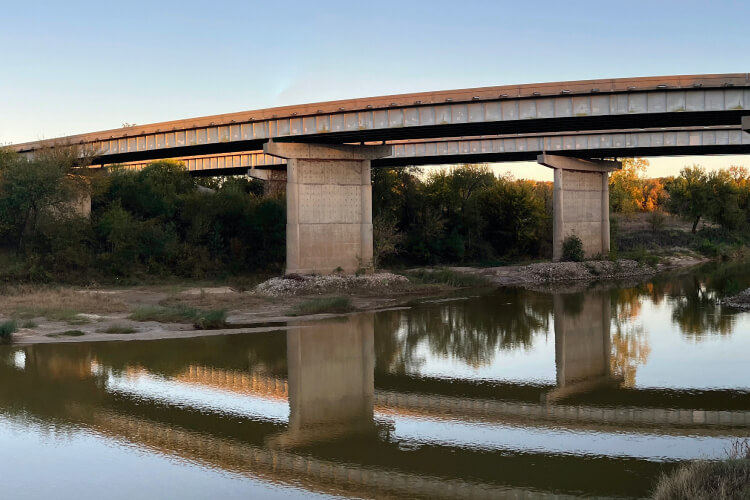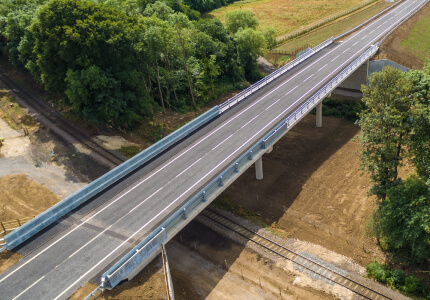The FM 159 project in Brazos County, Texas, represents a critical effort to address the ongoing threat posed by the encroachment of the Brazos River on a key transportation route. The Texas Department of Transportation (TxDOT) engaged Ulteig to develop a detailed design schematic, conducting environmental assessments and exploring feasible alternatives for the realignment of FM 159.
In partnership, TxDOT and Ulteig navigated the complexities of the project, ensuring a high-quality transportation infrastructure solution in alignment with TxDOT’s design criteria and overall strategic mission.
The Challenge: Addressing an Accelerating Threat
The FM 159 project is a response to the rapid encroachment of the Brazos River toward FM 159. Over the past several years, the river has been advancing at an alarming rate of approximately 15 feet per year, threatening to sever the roadway entirely within the next 5 to 10 years. This erosion, driven by natural river dynamics and exacerbated by frequent flooding events, has placed significant pressure on the infrastructure in the area.
TxDOT had previously attempted to mitigate a similar threat upstream by armoring the riverbank to prevent further erosion. However, a significant flood event undermined those efforts, washing away the protective measures and highlighting the need for a more robust solution at the location along FM 159. The challenge, therefore, was to develop a sustainable and cost-effective approach to preserving this vital transportation link.
Ulteig’s Work with TxDOT on FM 159
Ulteig was brought on board as the prime consultant for the FM 159 project, marking a significant milestone as our first major project in Texas. Ulteig’s team coordinated closely with TxDOT to push forward the design and environmental assessments despite delays caused by the COVID-19 pandemic. Our work on this phase of the project included:
Design Schematic Development: Ulteig developed a new alignment for FM 159, shifting the roadway approximately 1/4 mile north, parallel to the existing roadway and the BNSF railroad alignment. This realignment included the design of a two-lane roadway with 11-foot driving lanes and 6-foot shoulders, integrated within a proposed 100-foot right-of-way (ROW).
Environmental Documentation: Ulteig’s environmental team conducted thorough analyses to identify potential impacts and constraints. This work was crucial in informing the design process and ensuring compliance with regulatory requirements.
Alternatives Evaluation: An Alternatives Evaluation Matrix was developed, allowing Ulteig and TxDOT to collaboratively assess different design options. This tool was essential for making informed decisions that balanced environmental concerns, safety and cost-effectiveness.
Innovative Use of Technology: Ulteig successfully merged two 3D modeling programs— Bentley’s OpenRoads Designer and OpenBridge Modeler —which allowed for seamless integration of independently developed designs. This technological innovation improved the accuracy and efficiency of the design process.
Stakeholder Collaboration: Ulteig maintained open communication with TxDOT throughout the project, developing a comprehensive, interactive dashboard to track the project’s budget, schedule and DBE goals.
Overcoming Challenges and Constraints
In addition to delays caused by the COVID-19 pandemic, this phase of the FM 159 project faced unique obstacles. The proximity of the Brazos River and the dynamic nature of its erosion patterns required careful consideration of environmental impacts and the selection of a design that could withstand future flood events. An initial consideration of bridging the encroaching river was deemed too expensive given the relatively low traffic volume on FM 159, which primarily serves agricultural and freight traffic. This necessitated a more cost-effective solution, leading to the decision to realign the roadway.
Ulteig partnered closely with TxDOT to navigate these obstacles, completing our work in April of 2024.
The Importance of Resilient Transportation Solutions
Flooding poses one of the most significant challenges to transportation infrastructure, with increasingly frequent and severe events putting pressure on roads, bridges and other critical assets.
Projects like FM 159 exemplify the proactive steps that are essential to safeguarding transportation networks from the impacts of flooding. By addressing the threat of river encroachment and other flood-related risks, Ulteig helps Departments of Transportation preserve vital transportation links.
Leverage Forward-Thinking Transportation Engineering Solutions
FM 159 serves as a reminder of the importance of strategic planning, environmental awareness and collaborative design to ensure the longevity and safety of our transportation networks.
Ulteig is committed to developing transportation solutions that can withstand the test of time and nature. We invite you to connect with us to explore how we can work together on your next project, ensuring that our infrastructure remains resilient and reliable for the future.




